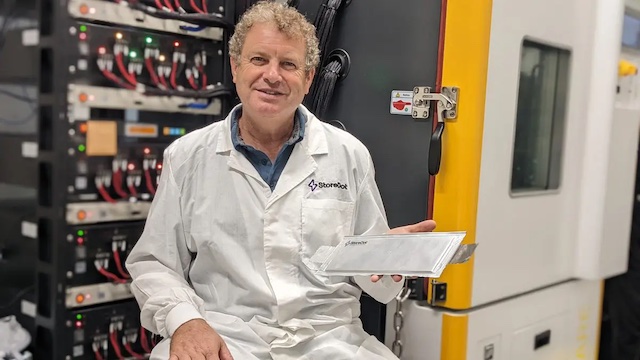
An electric car battery pack based on silicon that that can deliver 160km of range after a five-minute rapid charge? A sodium-sulphur battery that has four times the capacity of lithium? Electricity generated from humidity captured in the air?
Nope, there’s nothing fanciful about each of them. The silicon battery is here and now. Same with the sodium-sulphur battery. Harnessing electricity from humidity is in the experimental stages. All three developments show how quickly science has turned to finding sources for more sustainable energy.
• Israeli company StoreDot aims to have its Extreme Fast Charging (XFC) silicon technology available for EV batteries from next year.
• University of Sydney scientists have developed Australia’s first large-scale sodium-sulphur battery. It is now in use at a mine near Kalgoorlie.
• Scientists in the US are getting clean electricity literally from thin air. “The entire earth is covered with a thick layer of humidity,” said one.
StoreDot says its use of silicon instead of the metal oxides found in lithium-ion batteries provides faster charging and greater driving range compared with current technology.
Already a number of big-name companies – among them Volvo, Polestar, Mercedes-Benz parent Daimler AG, Samsung, and British Petroleum – have signed with StoreDot and its Chinese partner Eve Energy to help further XFC development.
In a company infographic StoreDot compares a car with a 80kWh lithium-ion battery pack and a range of 483km with one running a 50kWh silicon pack and a range of 320km. kWh is the efficiency rating of an EV.
A calculation has the lithium-ion car returning consumption figures of 16.6kWh/100km, while the silicon car delivers 15.6kWh/100km. StoreDot claimed that on the same fast charger the 50kWh battery charged from 10% to 80% inside 10 minutes, while the 80kWh pack took 40 minutes. The silicon battery charged at a rate of 3.5kWh a minute, the lithium-ion at 1.4kWh.
StoreDot CEO Doron Myersdorf (at top) claims its silicon technology could reduce the cost of building a new car by up to $NZ7200. It could also allow EV makers to use smaller and lighter batteries, thereby saving around 200kg in vehicle weight and reducing strain on the brakes, suspension and tyres.
“Radically reduced charging times will allow automotive manufacturers to rethink how they approach battery size and range,” Myersdorf said in a media statement. “When charging times are no longer an issue, it makes a lot more sense to fit smaller battery packs.”

In Australia, researchers are testing a low-cost sodium-sulphur battery (above) at a nickel-cobalt mine southeast of Kalgoorlie to see how the technology could be used to work with solar energy to power infrastructure in remote communities.
Project leader Dr Joshua Watts told the Sydney Morning Herald the battery can function in harsh climates. “The battery itself runs hot, around 300 degrees celsius, so it doesn’t need any air conditioning, so it’s perfect for the desert and hot, arid climates.”
Sodium is chemically similar to lithium, but whereas lithium is a rare earth, sodium is dirt cheap in comparison. It can also be found everywhere, from salt mines to the world’s oceans to dining tables. A further plus is that sodium-sulphur batteries don’t need cobalt, another rare earth mined mostly in Africa in operations plagued by human rights violations
Sodium-sulphur batteries are not new. The first was developed by Ford Motors in the 1960s. The sodium-sulphur battery in use in Kalgoorlie pretty much started as a block of molten salt. Sydney University’s Dr Shenlong Zhao took it from there to where it has four times the capacity of lithium.
Chinese companies CATL and BYD are producing sodium-based batteries for EVs for the first time this year. But experts say the technology is best suited to large-scale applications, in particular storing energy.
In the US, engineers at the University of Massachusetts have developed a prototype device they call the ‘Air-gen’. It is the size of a fingernail, thinner than a human hair, is dotted with tiny holes known as nanopores, and acts as a battery, using the energy from humidity.
“What we have invented, you can imagine it’s like a small-scale, man-made cloud,” Jun Yao, a professor of engineering and the senior author of the study, told The Washington Post.
“This is really a very easily accessible, enormous source of continuous clean electricity. Imagine having clean electricity available wherever you go.”
The holes in Air-gen have a diameter smaller than 100 nanometers, or less than a thousandth of the width of a strand of human hair. The microscopic holes allow the water in the air to pass through in a way that would create a charge imbalance in the upper and lower parts of the device, effectively creating a battery that runs continuously.
Engineers agree that continuing development posts an enormous challenge. For example, a billion or so Air-gen’s configured to the size of a refrigerator would be needed to continuously power a home.
“Once we optimise this, you can put it anywhere,” said Yao. “The entire earth is covered with a thick layer of humidity. It’s an enormous source of clean energy. This is just the beginning in making use of that.”
